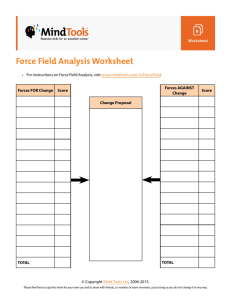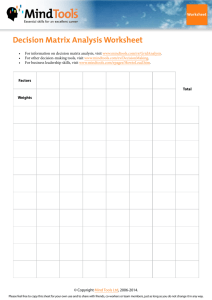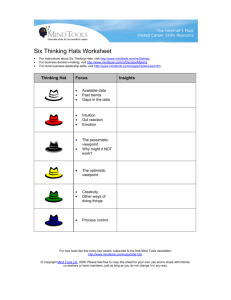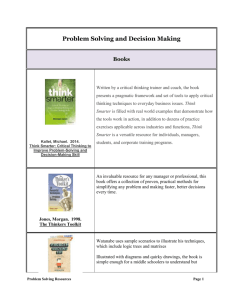Enlarging Your Sphere of Influence in Your Organization
advertisement
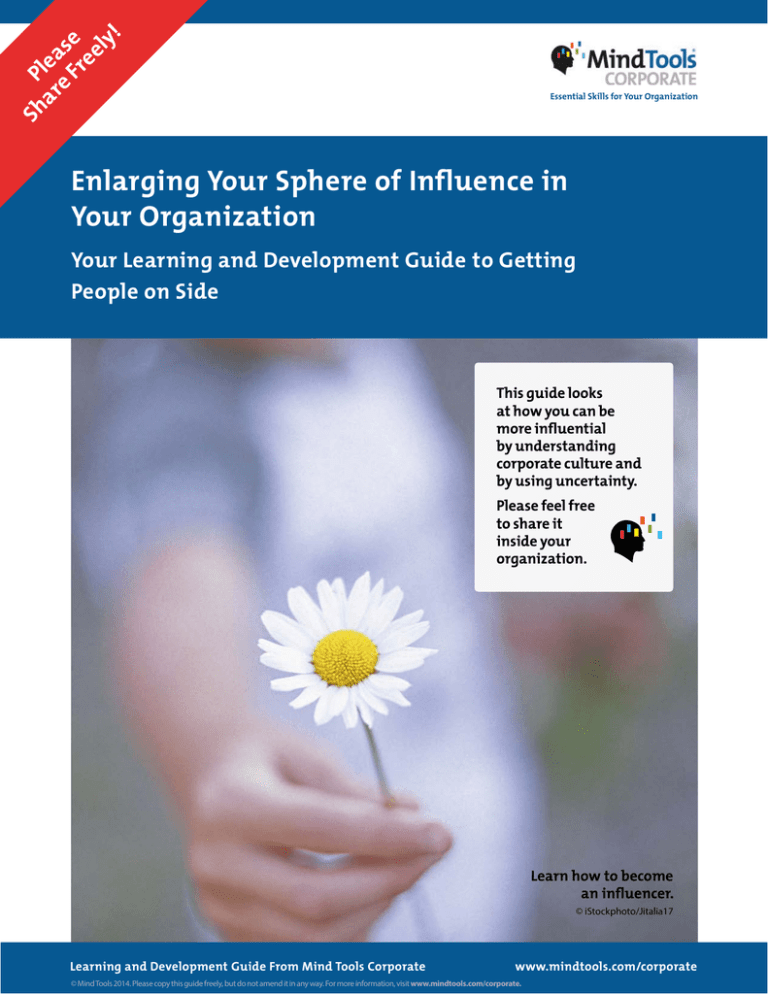
P ar lea e F se re el y! Sh Essential Skills for Your Organization Enlarging Your Sphere of Influence in Your Organization Your Learning and Development Guide to Getting People on Side This guide looks at how you can be more influential by understanding corporate culture and by using uncertainty. Please feel free to share it inside your organization. Learn how to become an influencer. © iStockphoto/Jitalia17 Learning and Development Guide From Mind Tools Corporate www.mindtools.com/corporate © Mind Tools 2014. Please copy this guide freely, but do not amend it in any way. For more information, visit www.mindtools.com/corporate. Essential Skills for Your Organization How can you have more influence in your organization? Since L&D professionals tend to have less “status” in their organizations than, say, those working in finance or IT, they often find themselves having to use their commonsense powers of persuasion to influence corporate decisions – rather than having the authority to say that a thing will (or will not) happen. Being a “people person” by both inclination and vocation, you – as an L&D professional – can take pride in being able to relate well to others. Using those same people skills to get them to agree with your agenda is another matter. Nonetheless, there are some techniques you can learn that should help. Developing Corporate Culture The first step to being a key influencer in your organization is to understand – and then develop – your company’s culture. • • • • • • • Harnessing the Power of Uncertainty In addition to developing corporate culture, the wouldbe influencer needs to consider the significance – and harness the power – of uncertainty. Uncertainty’s impact on contemporary working life means that, among other things: • Everyone leads a more fragmented life and lives in a world that has more instability than ever before. This causes us all to be more fearful about our futures. Organizational leaders aren’t exempt from this fear. They may – or may not – just be better at disguising their feelings. Discover and then tap into anyone’s businessrelated fears and you can influence them. • Uncertainty and change can provoke active engagement, enthusiasm and highly creative responses from people. This appears to happen when there’s a temporary corporate structure accompanied by short-term goals. Create the conditions for just such a structure and your corporate influence could grow – on the back of the increased engagement, enthusiasm and highly creative responses. • People are now expected to manage their own careers by cultivating a deep self-understanding and taking responsibility for improving their performance. There’s criticism that some organizations – that is, the L&D professionals in them – aren’t sufficiently supporting employees to enable them to adapt to this new era. Addressing this issue in a practical way might give you the leverage to increase your corporate influence. Culture is everywhere in organizational life – and it’s vital because of its impact on business performance. Before you can change a culture, you need to understand how it’s been created. In 1999, Edgar Schein – an organizational development specialist and former professor at the MIT Sloan School of Management – identified that culture can develop in six ways: • • • • • • Organizational evolution, where the business adapts naturally to the environment. Group evolution of teams or sub-groups within the organization to their environments. Guided evolution resulting from cultural “insights” on the part of the leaders. Autonomous evolution through encouraging teams to learn from each other and empowering selected hybrids from sub-cultures that are better adapted to current realities. Planned and managed culture change through creating parallel systems of steering committees and project-oriented taskforces. Part or total cultural destruction through new leadership that eliminates the former culture’s carriers. Achieving cultural change doesn’t happen overnight. To be successful, you should: • Link the change to organizational vision, mission and objectives – paying particular attention to stakeholder (not just employee) issues. Create a sense of urgency and continually reinforce the need to change. Remember that the “how” of culture change is as important as the “what.” Build on the old and use it to step into the new. Generate enabling mechanisms. Act as a role model. Develop supporters by creating a community of focused and flexible leaders. Stress collective ownership for the changes – don’t make it purely an HR/L&D department initiative. You can harness the power of uncertainty, lead change and, thus, be a key influencer in your organization by: Learning and Development Guide From Mind Tools Corporate www.mindtools.com/corporate © Mind Tools 2014. Please copy this guide freely, but do not amend it in any way. For more information, visit www.mindtools.com/corporate. Essential Skills for Your Organization • • • • • Being present and engaging in “deep listening.” In other words, ensure that you’re alert – and really listening – to what’s going on in your organization. Defining a clear context into which others can step. Being confident in challenging situations and providing a bounded space for others to air their anxieties, both in one-on-one and group settings. Resisting the urge to act, or drive anyone to come up with a quick solution, but, instead, aiming to hold the creative tension. Looking after yourself both physically and mentally – being your own “container” and developing deeper skills that enable a quieting of the mind. The Fruits of Influence a new balance between sensing, analyzing, discussing, and “getting on and deciding.” • Leaders need to understand which decisions they need to make themselves and which are important for their teams to make. In a matrix organization, some decision making may be better done in partnership with stakeholders rather than in isolation. Research by Paul C. Nutt of Ohio University indicated that successful top executives include all four Myers-Briggs modes of understanding in their decision-making style. This helps them overcome the distractions of ambiguity and uncertainty. David J. Snowden and Mary E. Boone have proposed a framework to help leaders identify the decision making context and select an appropriate approach. • Effective leaders make choices between imperfect solutions and need to accept this. Adherence to a particular choice leads to inflexibility, blaming and a lack of learning. Learning to experience the joy, sadness and regret of decision making helps leaders to be more effective in an uncertain, pluralistic environment. • Like poker, decision making can be seen as a game of skill with a twist of luck, rather than as an exact science. Eventually, if you follow these guidelines, you’ll become more influential in your organization – and get to make some key decisions. This, in turn, will make you a real leader in your business. When this happens, you need to bear in mind that: • Decisiveness is often associated with leadership strength, while dithering is seen as weak, especially in the U.S. and the U.K. Yet, faced with today’s growing uncertainty, you need to strike Visit www.mindtools.com/corporate to find out how your organization can access more than 1000 resources on leadership, management, problem solving, and communication. You can also license more than 60 one-hour training courses and hundreds of business podcasts. Used together, these will help you develop and embed skills organization-wide. Learning and Development Guide From Mind Tools Corporate www.mindtools.com/corporate © Mind Tools 2014. Please copy this guide freely, but do not amend it in any way. For more information, visit www.mindtools.com/corporate.
